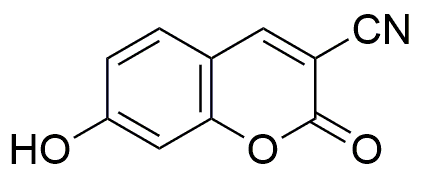3-Cyanoumbelliferone is widely utilized in research focused on:
- Fluorescent Probes: This compound is often used as a fluorescent probe in biochemical assays, allowing researchers to visualize and track biological processes in real time.
- Antioxidant Studies: It serves as a valuable tool in studying antioxidant properties, helping researchers understand how certain compounds can protect cells from oxidative stress.
- Drug Development: Its unique structure makes it a candidate for developing new pharmaceuticals, particularly in the field of cancer research, where it may help in designing targeted therapies.
- Photodynamic Therapy: 3-Cyanoumbelliferone is explored for its potential in photodynamic therapy, a treatment that uses light-sensitive compounds to kill cancer cells.
- Analytical Chemistry: This compound is utilized in analytical methods to detect and quantify various substances, enhancing the accuracy of chemical analysis in laboratories.
General Information
Properties
Safety and Regulations
Applications
3-Cyanoumbelliferone is widely utilized in research focused on:
- Fluorescent Probes: This compound is often used as a fluorescent probe in biochemical assays, allowing researchers to visualize and track biological processes in real time.
- Antioxidant Studies: It serves as a valuable tool in studying antioxidant properties, helping researchers understand how certain compounds can protect cells from oxidative stress.
- Drug Development: Its unique structure makes it a candidate for developing new pharmaceuticals, particularly in the field of cancer research, where it may help in designing targeted therapies.
- Photodynamic Therapy: 3-Cyanoumbelliferone is explored for its potential in photodynamic therapy, a treatment that uses light-sensitive compounds to kill cancer cells.
- Analytical Chemistry: This compound is utilized in analytical methods to detect and quantify various substances, enhancing the accuracy of chemical analysis in laboratories.
Documents
Safety Data Sheets (SDS)
The SDS provides comprehensive safety information on handling, storage, and disposal of the product.
Product Specification (PS)
The PS provides a comprehensive breakdown of the product’s properties, including chemical composition, physical state, purity, and storage requirements. It also details acceptable quality ranges and the product's intended applications.
Certificates of Analysis (COA)
Search for Certificates of Analysis (COA) by entering the products Lot Number. Lot and Batch Numbers can be found on a product’s label following the words ‘Lot’ or ‘Batch’.
*Catalog Number
*Lot Number
Certificates Of Origin (COO)
This COO confirms the country where the product was manufactured, and also details the materials and components used in it and whether it is derived from natural, synthetic, or other specific sources. This certificate may be required for customs, trade, and regulatory compliance.
*Catalog Number
*Lot Number
Safety Data Sheets (SDS)
The SDS provides comprehensive safety information on handling, storage, and disposal of the product.
DownloadProduct Specification (PS)
The PS provides a comprehensive breakdown of the product’s properties, including chemical composition, physical state, purity, and storage requirements. It also details acceptable quality ranges and the product's intended applications.
DownloadCertificates of Analysis (COA)
Search for Certificates of Analysis (COA) by entering the products Lot Number. Lot and Batch Numbers can be found on a product’s label following the words ‘Lot’ or ‘Batch’.
*Catalog Number
*Lot Number
Certificates Of Origin (COO)
This COO confirms the country where the product was manufactured, and also details the materials and components used in it and whether it is derived from natural, synthetic, or other specific sources. This certificate may be required for customs, trade, and regulatory compliance.

